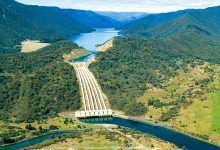The developers of Snowy 2.0 say the massive pumped hydro project is now expected to reach full commercial operation in December 2028 – seven years later than originally forecast – as they confirm reports that the bill for development has ballooned to a massive $12 billion.
The federal government on Thursday announced the full public release of the outcomes from Snowy Hydro’s major projects resets, both for Snowy 2.0 and the Hunter Power Project – one day after the eye-watering new costs for the hydro project were leaked to the media.
Federal energy minister Chris Bowen says the Albanese government, which owns Snowy Hydro, received the company’s updated Corporate Plan and results of its project review two days ago, including the news that $4.3 billion has already been sunk on costs, to date.
The review also confirms that the price of building Snowy 2.0, originally estimated at $2 billion, has doubled again to since the start of the year – although some experts have suggested the new $12 billion number does not account for all of the project costs.
Bowen says Snowy’s advice to government on the massive cost blowouts point to “design immaturity” at the time of the project’s final investment decision (FID) and “site conditions and geology” – which the minister says should have been known at the time.
“For example, the fact that tunnel boring machine Florence would encounter soft ground should not have come as a surprise, but has significantly impacted the project,” a government statement says.
According to Snowy Hydro’s report, the “revised total cost to complete” Snowy 2.0 is now estimated at $12 billion, with expenditure on the project totally $4.3 billion at the end of June 2023, with 80% of these funds reinvested in the Australian economy.
The review also says that Snowy 2.0 will deliver an additional 200MW or 10% of generation capacity when it comes online, bringing the project’s total capacity to 2,200MW (2.2GW).
Snowy Hydro says that despite the huge cost blowouts and ongoing engineering challenges, the project “remains economic” and – somewhat remarkably – still offers a net present value of around $3 billion to Australian taxpayers.
“Snowy 2.0 involves billions of dollars of investment, with approximately 80% going into Australian jobs, goods, services and skills,” says Snowy Hydro CEO Dennis Barnes.
“We are building the skills of local workers that can later be used elsewhere to assist in Australia’s ongoing energy transition.”
But the claimed cost benefits of Snowy 2.0 will no doubt be the subject of close scrutiny, particularly from critics of the project who believe it should be halted pending an independent review into costings.
Ted Woodley, an energy industry veteran and long-time critic of Snowy 2.0, says the new bill for the pumped hydro project well and truly eclipses any financial returns it has promised to deliver, including the $4.3 – $6.6 billion estimate put forward in the feasibility study.
Bowen says that how the project proceeds from here will be crucial to avoiding further cost blowouts. To this end, Snowy Hydro says it has agreed to new terms of its contract with Future Generation Joint Venture (FGJV) to move to an Incentivised Target Cost contract model.
“Crucially, Snowy Hydro has advised government that if this contractual change is not made, it would lead to further cost escalation and delays.”
The outlook from the Snowy Hydro management team is largely optimistic.
“Moving to an incentivised target model with FGJV will result in closer collaboration, stronger oversight and alignment of interests between Snowy Hydro and FGJV,” Barnes said on Thursday.
“Snowy 2.0 is being engineered to deliver clean and reliable storage and electricity generation for Australians for the next 150 years.
“It is a truly transformative national project that is generating jobs and significant investment in regional areas; it will deliver benefits immediately following its completion and will continue to do so for many future generations of Australians.”
The company says construction of Snowy 2.0 is now around 40% complete and solid progress continues to
be made, including on tunnel excavation, work on the underground power station and manufacture of pump turbines.
The project is now expected to be fully up and running a year ahead of the December 2029 date given to the federal government at the start of the year – which puts it seven years behind the original schedule, instead of eight.
Snowy Hydro says it expects first power to be delivered in the second half of 2027, with a target date for commercial operation of all units penciled in for December 2028.



